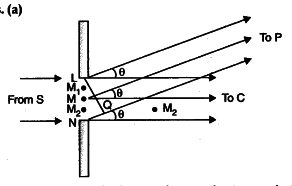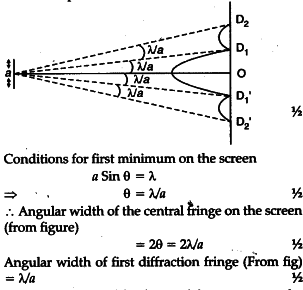(a) Using Huygens’s construction of secondary wavelets explain how a diffraction pattern is obtained on a screen due to a narrow slit on which a monochromatic beam of light is incident normally.
(b) Show that the angular width of first diffraction fringe is half that of the central fringe.


We can regard the total contributions of the wavefront LN at some point P on the screen, as the resultant effect of the superposition of its wavelets like LM, MM2, M2N. These have to be superpose taking into account their proper phase differences. We therefore, get maxima and minima, i.e. a diffraction pattern, on the screen.
(b)
Hence angular width of central fringe is twice the angular width of first fringe.
© Maxima become weaker and weaker with increasing n. This is because the effective part of the wavefront, contributing to the maxima, becomes smaller and smaller, with increasing n.